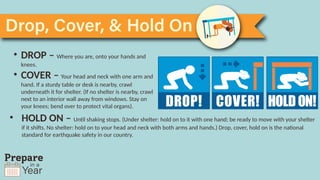Drop cover and hold training 60e5f5da95e4f.pptx
- 1. Drop, Cover, and Hold On
- 2. Conquering the instinct to run • We learn to counter the human tendency to run by practicing doing the safe thing. • Studies show that people tend to be hurt by falling objects, not collapsing structures. • Facades of buildings or glass from windows can be falling and injure those running out during an event.
- 3. • DROP – Where you are, onto your hands and knees. • COVER – Your head and neck with one arm and hand. If a sturdy table or desk is nearby, crawl underneath it for shelter. (If no shelter is nearby, crawl next to an interior wall away from windows. Stay on your knees; bend over to protect vital organs). • HOLD ON – Until shaking stops. (Under shelter: hold on to it with one hand; be ready to move with your shelter if it shifts. No shelter: hold on to your head and neck with both arms and hands.) Drop, cover, hold on is the national standard for earthquake safety in our country.
- 4. TIP: Visit dropcoverholdon.org to find advice for persons with access or functional needs.
- 5. If driving: Near the coast: • Pull over to the side of the road, stop, and set the parking brake. • Avoid overpasses, bridges, power lines, signs and other hazards. • Stay inside the vehicle until the shaking stops, then proceed carefully by avoiding fallen debris, cracked or shifted payment and emergency vehicles. • If a power line falls on the car, stay inside until a trained person removes the wire. • IF THE GROUND SHAKES... • IF YOU HEAR A SIREN... • IF THE OCEAN RECEDES FROM THE SHORELINE... • TAKE YOUR PREPARED GRAB AND GO KIT, • IMMEDIATELY - HEAD FOR HIGH GROUND! TIP: Three steps to take after an earthquake: 1. Check yourself for injuries. 2. Check the people around you for injuries. 3. Check your environment. Is it safe for you to stay where you are?
- 6. What If There’s No Cover? Drop, Cover, and Hold On BETWEEN OR BESIDE something sturdy.
- 7. Use the Web shakeout.org/washington dropcoverholdon.org mil.wa.gov/shakeout Local Resources Contact local and state emergency management offices for more information







